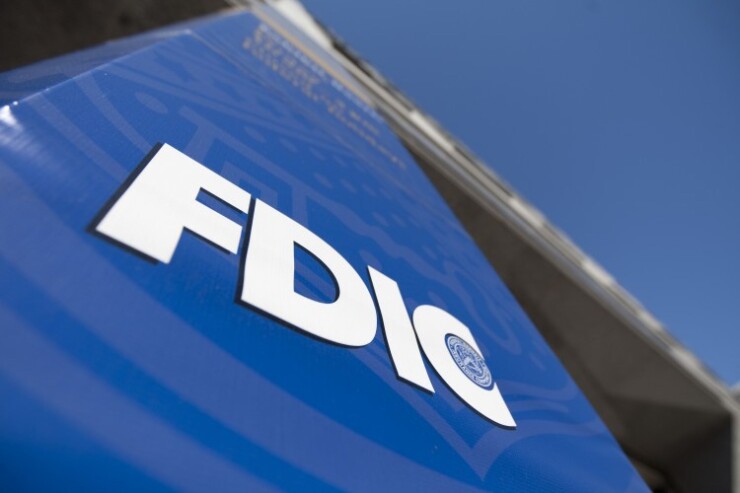
The Federal Deposit Insurance Corp. acknowledged in a
"[The FDIC's Risk Management Supervision unit] could have been more forward-looking in assessing how increasing interest rates could negatively impact the bank, given its concentration of lower-rate, longer-duration loans and dependence on low-cost funding and continual growth," the report said.
"RMS could have done more to effectively challenge and encourage bank management to implement strategies to mitigate interest rate risk starting in the second half of 2021 … [and] pursued a more urgent supervisory response, such as potentially downgrading the Sensitivity to Market Risk component and/or issuing [supervisory recommendations] urging management to develop strategies to mitigate interest rate risk."
Friday's report comes as the FDIC and other regulators are already taking a multitude of actions to prevent future bank failures such as proposals to raise
The San Francisco based bank's demise in May — the second-largest bank failure in U.S. history — was triggered by a surge in deposit withdrawals after customers caught wind of First Republic's declining financial health, leading
FDIC — the primary federal supervisor of First Republic — noted that while hindsight puts into stark relief the bank's underlying vulnerabilities, the agency consistently gave bank management "strong" supervisory ratings and rated the bank "satisfactory" during the four years before the failure. FDIC further found that examination staff said that bank management was responsive to supervisory feedback and recommendations, quick to remediate findings and easy to work with.
What those chummy relations obscured, however, was that First Republic's business model had a multitude of vulnerabilities. The FDIC concluded that more proactive supervisory actions — such as addressing interest rate risk or liquidity risk management — might not have prevented First Republic's failure given the magnitude and speed of deposit withdrawals. However, it emphasized that meaningful actions to mitigate interest rate risk and address funding concentrations would have made the bank less vulnerable to the contagion effects during the banking crisis this spring.
A major vulnerability was the firm's heavy reliance on uninsured deposits, a concentrated and volatile source of funding. As interest rates rose, FDIC said the banks' asset-liability mismatch became apparent.
"First Republic's assets were concentrated in longer-term loans that generated low interest income, while deposits required to fund those loans were short-term. Starting in the September 2022 time frame, customers began moving from non-interest-bearing accounts to time/certificate of deposit (CD) accounts, shifting the cost structure from minimal to higher cost accounts," the report noted. "This shift increased First Republic's interest expense and compressed [its] net interest margin."
The bank's troubles intensified when contagion effects from the March failure of Silicon Valley Bank spread on channels like social media. First Republic's disproportionately sophisticated investors — many of whom, like SVB's customers, were based in the venture capital and tech sectors — began to withdraw their deposits, triggering a run.
"Contagion effects from SVB's failure began to spread through traditional media, social media, and short sellers to other banks with perceived similar risk characteristics," the report noted. "While First Republic was initially able to manage liquidity to meet withdrawal requests, management's strategic decision to retain a long-standing business model with a significant asset/liability mismatch during a period of rising interest rates contributed to a loss of confidence in the bank on the part of depositors, and, ultimately constrained options for the bank to restructure its balance sheet by selling assets or raising capital."
As contagion effects escalated, the bank had to borrow substantial amounts of liquidity from the Federal Home Loan Bank System and the Federal Reserve's discount window to balance its books. Despite efforts to slow the outflows, a substantial loss of deposits in the first quarter triggered a negative market response, a significant drop in the bank's stock price, and a resumption of substantial deposit outflows.
Much of First Republic's susceptibility to contagion was attributed to its rapid growth in years leading up to its demise. The FDIC noted in its report that in the four-year window leading up to the failure, First Republic doubled in size while actual examination hours declined 11%. While the FDIC maintained that the bank was adequately supervised and staffing shortages were not broadly cited as an issue, it admitted that such rapid growth should have been monitored more closely.
"While we would not expect examination hours to parallel asset growth and while there could be explanations such as examination efficiencies on the surface, this trend appears counterintuitive and may have warranted greater explanation in annual supervisory plans," the FDIC report said. "While First Republic's growth was not as aggressive as SVB or Signature Bank, which experienced annual asset growth rate of 45% and 31%, respectively, First Republic grew about twice as rapidly as its peer banks."
FDIC's post-mortem review marks the second time this year it reflected on its handling of a failed bank, following a





